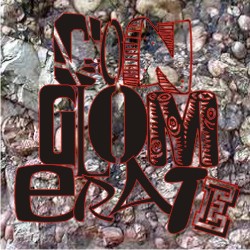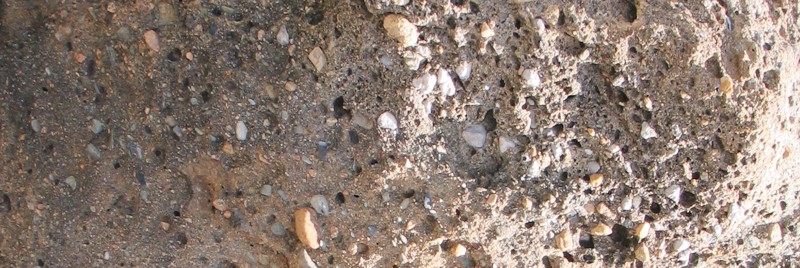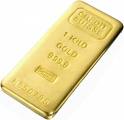
From the guidelines, as from January 2013"People do not need to wait for permission to log your EarthCache. Requiring someone to wait is not supported by the EarthCache guidelines. People should send their logging task answers to you, then log your EarthCache. When you review their logging task answers, if there is a problem, you should contact them to resolve it. If there is no problem, then their log simply stands."

In geology a simple explanation of what a conglomerate is might be that it is a rock consisting of individual stones, or clasts, that have become cemented together. Conglomerates are typical sedimentary rocks consisting of rounded fragments cemented in a matrix.
individual stones, or clasts, that have become cemented together. Conglomerates are typical sedimentary rocks consisting of rounded fragments cemented in a matrix.
 Conglomerates differ from breccias, which are similar in morphology but consist of angular clasts. Both conglomerates and breccias are characterized by clasts larger than sand (>2 mm).
Conglomerates differ from breccias, which are similar in morphology but consist of angular clasts. Both conglomerates and breccias are characterized by clasts larger than sand (>2 mm).
Characterising a conglomerate
Two distinctive varieties of conglomerates (and breccias) are defined on the basis of texture:
1 - Paraconglomerates consist of a matrix-supported rock that contains at least 15% sand-sized or smaller grains (<2 mm), the rest being larger grains of varying sizes, and

2 - Orthoconglomerates are defined by texture. They are a grain-supported rock that consists primarily of gravel-sized grains (~256 mm), with less than 15% matrix of sand and finer particles.

Conglomerates can be further classified on the basis of their composition of framework and matrix grains:

Intraformational- conglomerates and breccias have an interior (intrabasinal) source: that is; they are eroded from the same sedimentary rock unit they are a part, rather than being derived from rocks located outside the depositional basin. Consequently intraformational conglomerates and breccias have framework grains identical in composition to those in the matrix.
Extraformational- conglomerates and breccias are derived from sources areas outside the depositional basin. Detritus weathered from external sources is carried away and deposited elsewhere. As a result framework clasts differ markedly in composition from matrix.Framework matrix is exotic; that is, not derived by the erosion and redeposition of matrix material.

Oligomict or petromict?
In oligomict (orthoquartzose) conglomerates (or breccias), more than 90% of the framework clasts consist of fragments of only a few varieties of resistant rocks and minerals as quartzite, vein quartz, and cherts.
Inpetromict (polymict) conglomerates, clasts of many different composition of metastable and unstable rocks are abundant; for example, basalt, slate, and limestone. Generaly petromic conglomerates are much more abundant than oligomict orthoconglomerates and are mainly alluvium eroded from high-relief areas.
Why are conglomerates important?

 Conglomerates (and breccias) provide rocks with varying aesthetic beauty. In many instances these can be used to generate dimension stone. A perfect example lies in the Arrábida Breccias (Brecha da Arrábida).
Conglomerates (and breccias) provide rocks with varying aesthetic beauty. In many instances these can be used to generate dimension stone. A perfect example lies in the Arrábida Breccias (Brecha da Arrábida).
Alternatively, conglomerates can hold wealth unlike any other type of rock. The classic example are the auriferous conglomerates from the Wits Basin in South Africa. These have pyrite and gold and were discovered on the farm Langlaagte by Geoge Harrison in 1886 and since then South Africa has been one of the world’s foremost gold producers.
Geological setting
The geological outcrops in the vicinity date from the Upper Jurassic (kimmeridgian; 146 – 141 Ma.) and the rather small outcrop in the Guincho beach is denominated the “Limestones and Marls of Sta. Cruz” which are truncated in the E, NE and S by faults.
The outcrop is approximately 50 m long and is made up of basal limestones, silty marls and fine arenites. They are predominantly dark-grey to black in colour grading to bluish at the top. The black colour suggests a high percentage of organic matter.
Above the Limestones and Marls of Sta. Cruz occur 40 m of conglomeratic arenites with clasts of granite, schist and limestone.
Manupella, G et al., 1996. Geological map of Portugal, Sheet 30A (Lourinhã); Scale 1:50000, Instituto Geológico e Mineiro, Lisbon.
Manupella, G et al., 1999. Explanation booklet, Sheet 30A (Lourinhã); Instituto Geológico e Mineiro, Lisbon, 83 p.
Claiming the earthcache
The above coordinates will take you to a conglomerate outcrop on the beach. The question is simple: Please tell me if the conglomerate in front of you is clast- or matrix-supported, i.e. it is an orthoconglomerate or a paraconglomerate. Send me your answers via e-mail through my GC profile to validate your found.
Note: no tell-tale pics of the outcrop!
Happy earthcaching!
 The most exciting way to learn about the Earth and its processes is to get into the outdoors and experience it first-hand. Visiting an Earthcache is a great outdoor activity the whole family can enjoy. An Earthcache is a special place that people can visit to learn about a unique geoscience feature or aspect of our Earth. Earthcaches include a set of educational notes and the details about where to find the location (latitude and longitude). Visitors to Earthcaches can see how our planet has been shaped by geological processes, how we manage the resources and how scientists gather evidence to learn about the Earth. To find out more click HERE.
The most exciting way to learn about the Earth and its processes is to get into the outdoors and experience it first-hand. Visiting an Earthcache is a great outdoor activity the whole family can enjoy. An Earthcache is a special place that people can visit to learn about a unique geoscience feature or aspect of our Earth. Earthcaches include a set of educational notes and the details about where to find the location (latitude and longitude). Visitors to Earthcaches can see how our planet has been shaped by geological processes, how we manage the resources and how scientists gather evidence to learn about the Earth. To find out more click HERE.

